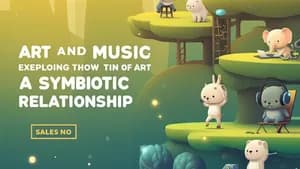This article explores the use of color theory in both art and music, demonstrating how analogous and complementary palettes create similar emotional responses across the two mediums. We'll examine how artists and composers utilize color and harmony to evoke specific moods and atmospheres.
The Language of Color in Art
Color, in the visual arts, is far more than just aesthetics; it's a powerful tool for communication. Think about your favorite painting – what emotions does it evoke? Is it a feeling of warmth and joy, or perhaps a sense of cool detachment or mystery? The artist likely achieved this through careful consideration of color theory. Understanding the color wheel – its primary, secondary, and tertiary colors – is crucial. Analogous colors sit next to each other on the wheel (like blues and greens), creating a harmonious and often calming effect. Complementary colors, on the other hand, sit opposite each other (like red and green), producing a more vibrant and sometimes dramatic contrast. You can experiment with these relationships yourself by creating simple color studies. Try painting a landscape using analogous colors for a serene feel, then try another using complementary colors to see how the mood shifts. Pay close attention to how different color combinations affect the overall feeling of your artwork. For example, warm colors like reds and oranges tend to advance visually and evoke feelings of energy and excitement, whereas cool colors like blues and greens tend to recede and can create a more tranquil atmosphere. Remember that the context of the colors is also vital – a splash of bright red in a predominantly blue piece can be strikingly impactful.
The Language of Harmony in Music
Just as visual artists manipulate color, musicians use harmony to create emotional responses. Harmony, in music, refers to the simultaneous combination of notes. Like analogous colors in art, consonant chords (those that sound pleasing together) create a sense of stability and peace. Think of the major chords in a simple pop song; they're generally uplifting and happy. Dissonant chords, on the other hand, create tension and unease – these are often used to build drama and anticipation before a resolution. This is analogous to using complementary colors in art. The relationship between consonant and dissonant harmonies mirrors the analogous and complementary relationships in color theory, creating similar emotional impacts in the listener. Listening to a piece of music and actively identifying the types of chords used can help you understand the composer's intent. Try to listen for the shifts from consonant to dissonant harmonies. You'll start to notice how these shifts contribute to the emotional arc of the piece.
Connecting Color and Harmony: A Cross-Disciplinary Approach
The parallels between color in art and harmony in music are striking. A painting dominated by warm, analogous colors might evoke a similar feeling of comfort and joy as a musical piece built on primarily major, consonant chords. Similarly, a piece of art utilizing strong complementary colors, creating visual tension, mirrors the emotional impact of a musical piece employing dissonant harmonies. You can actively draw connections between the two forms by conducting a comparative analysis. Choose a painting and a piece of music you enjoy. Analyze the color palette of the artwork and identify the types of harmonies used in the music. Note the emotions each piece evokes and consider how the use of color and harmony contributes to the overall emotional impact. You might be surprised by the subtle yet powerful connections you discover.
Practical Exercises for Students
To deepen your understanding, consider these activities: First, choose a favorite painting and create a corresponding musical piece using instruments or software, mirroring the color palette and emotional impact. Use warm colors and major chords for a happy piece, or cool colors and minor chords for something melancholic. Alternatively, choose a musical piece and create a visual artwork that embodies its emotions and harmonies. A dramatic piece with dissonant harmonies might inspire a painting with contrasting, complementary colors. These exercises help solidify the connection between these two art forms and improve both your artistic and musical capabilities. Don't be afraid to experiment; the goal is to explore the relationship, not necessarily to create a masterpiece. This approach encourages creativity and enhances learning through hands-on application. Remember to document your process – jot down your thoughts and observations about the connections you see.
The Emotional Impact: Beyond Theory
Beyond the theoretical framework of color theory and harmony, consider the cultural context of color and music. Certain colors and musical modes carry specific cultural connotations that influence emotional interpretation. For example, the color white might symbolize purity in some cultures, while black might represent mourning in others. Similarly, certain musical scales might be associated with specific emotions or events in different cultural traditions. Understanding these nuances enriches your appreciation of art and music. Researching the cultural significance of color and musical modes in different parts of the world adds depth to your understanding and encourages critical thinking. Try focusing your explorations on a specific culture to see how these symbolic uses interact within a particular community's artistic expressions. The more you explore, the deeper your understanding will become. Remember that this exploration is about enhancing your overall understanding and enjoyment of art and music – two powerful ways to engage with your own creativity and the world around you.

